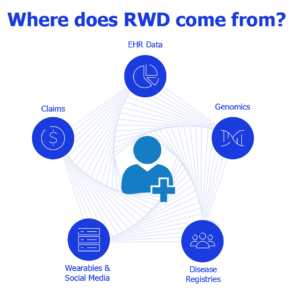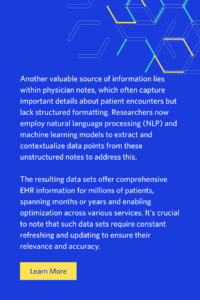Concepts once thought to be theoretical are now a reality — from smartphones to space flights. In comparison, the new reality for life sciences organizations is the emerging importance and utility of real-world data (RWD) and real-world evidence (RWE). These newly tapped resources can enable organizations to build better insights, achieve better outcomes, lower risk, and reduce overall costs.
Macro Pressures Related to Signal and Risk Management
We are at an inflection point in life sciences; RWD and RWE are transforming insight and are utilized at a scale not seen before. However, the macro pressures on signal and risk management necessitate awareness, change, and progress within life sciences. These pressures for signal and risk management include:
- The increased prevalence of RWD/RWE in clinical trials and post-approval environments across the drug development lifecycle
- Noisy signal environments and manual processes faced by teams looking at the data
- The need to move with efficiency
Despite these pressures, there is an opportunity to leverage software and tools to overcome the challenges and progress to deriving insight that can increase insights from signals to ultimately improve the patient experience and increase organizational profitably.
Defining Real-World Data and Real-World Evidence
Let’s start with establishing what RWD and RWE mean within this context. The United States Food and Drug Administration (FDA) have utilized these concepts as evidence for their Sentinel Initiative and now, with the Advancing Real-World Evidence Program. Since the FDA has a long history of utilizing these concepts, our definition of each follows its own:
- Real-World Data (RWD)* is data relating to patient health status and/or the delivery of health care routinely collected from a variety of sources.
- Real-World Evidence (RWE)* is the clinical evidence about the usage and potential benefits or risks of a medical product derived from the analysis of RWD.
The Value Behind and Push to Use Real-World Data in Public Health, Industry, and Regulatory
Electronic health records (EHR), claims data, medical events, wearables, and specific patient data related to health status are aspects of RWD that can bring us closer to the patient and deliver deeper insights. RWD assists with patient advocacy and safety investigations but, more specifically, can be a fundamental element of signal detection, where pharmacovigilance teams use it to anticipate needs and optimize decision-making, thus improving patient safety and limiting anticipated adverse events.

One notable advantage of RWD is its increasing availability and diversity and therefore adding potential value to the life sciences. These data are generated as a routine part of hospital activities without the need for additional reporting or data collection systems. This means that the potential for signal detection and safety integration is significant, offering faster and more cost-effective circulation.
The significant growth in data within life sciences and the effective use of RWD opens up numerous opportunities for organizations. The result is the extensive RWD usage in health research and business, including:
- Link patient health outcomes to various drugs and devices using retrospective studies
- Inform policies within the Department of Health and Human Services (DHHS) and other government agencies
- Fill gaps in public health surveillance
- Leverage observational healthcare databases, such as Odyssey, for the benefit of medical products
- Use FDA Sentinel to harness RWD to facilitate signal detection and analysis, providing insights to healthcare providers, electronic health record (EHR) companies, software developers, and drug manufacturers through standardized queries
To fully harness the potential of RWD, it is essential to consider its specific applications. An example of a specific type of RWD is claims data. One common characteristic shared by different types of RWD is that they are not collected or generated solely for research or signal detection purposes. This unique aspect enables a fit-for-purpose approach that aligns with the specific needs of each use case.
What is a fit-for-purpose solution?
Not all data is useful to drug development, and with a plethora of patient data, it needs to be fit for purpose. Administrative claims can be likened to receipts. They lack important information such as vital signs, lab results, and detailed clinical information essential for comprehensive patient assessment. Similarly, electronic health records primarily serve the purpose of documenting clinical decisions and supporting administrative functions. This raises the crucial question of assessing fit-for-purpose systematically, repeatedly, and defensibly. While they hold value as RWD, they must be harnessed correctly to provide the essential information to benefit drug development and patient care.
In terms of content, the data source must provide sufficient details about the drug, treatment duration, and current treatment. Adequate reporting of adverse events and reactions is crucial.
Data that is fit for purpose holds all necessary identifiers. Sample size and population characteristics are other key factors to evaluate. Rare adverse events necessitate a large denominator for meaningful testing. Equally important is understanding the representation of patients within the data. Do the patients in the data represent the entire treated population, or are they a specific subset? Medicare data, for instance, primarily includes claims from older Americans, impacting the generalizability of findings.
De-identification plays a role in the increased availability and accessibility of RWD. While patient identifiers are removed, indirect identifiers such as data services or diagnoses of rare diseases or events may still exist. Understanding how the data was generated and transformed is essential for a comprehensive evaluation. This includes insights into the methodologies, procedures, and any transformations applied to the data throughout its lifecycle. By obtaining such transparency, one can ascertain the reliability, accuracy, and suitability of the data and determine if it is fit for purpose.
Real-World Data for Signal Detection
Today, only a few types of global data are readily available on a large scale with sufficient detail to support signal detection. EHRs and claims data are among these prominent data sources. EHRs provide coverage and data for millions of patients, encompassing various patient demographics, procedures, diagnoses, vitals, and test results. Similarly, claims data contains many patients and cover services across different settings, allowing for efficient curation and reporting due to their structured data elements. However, it is important to note that the coding systems used in these sources primarily serve patient management and billing purposes, requiring adaptation for research purposes.
Utilizing Natural Language Processing to Identify Adverse Drug Events
Current systems are in place to ensure safety, so the focus is now on enhancing these systems with the use of global data. By augmenting readily available sources, a holistic picture of clinical patients can be obtained, enabling the identification of signals, and improving overall safety. OMNY Health completed a study on the potential of global data to detect adverse events.
In their study, OMNY Health utilized natural language processing (NLP) to identify adverse events within EHR data. They hypothesized that these events were encoded within the EHR data and utilized commercially available NLP software to identify them. After launching the software within the hospitalization records of 5000 patients on ACE inhibitors and 5000 without, they were able to detect higher rates of adverse events in the patients treated with ACE inhibitors.
What does this mean? The application of advanced technology is only just beginning. RWD and RWE have the unique ability to provide additional insight that was not available before by pairing it with technology that only continually becomes more powerful. The testing of OMNY’s hypothesis and subsequent findings demonstrates that the opportunities exist to extrapolate knowledge from data that has not previously been considered relevant.
Out of Pressure Comes Opportunity
Opportunities often arise from challenges. By augmenting and improving their approach to the utilization of RWD and RWE, life sciences organizations can expect faster and more patient-centric signal detection, providing deeper insights and bolstering confidence for reporting and decision-making.
Furthermore, this presents an opportunity to establish a new industry standard. While initial skepticism may arise, it is reminiscent of the revolution brought by FICO scores, which have now become the accepted norm in the industry. The industry is at an inflection point where these discussions are gaining momentum, and organizations have a chance to contribute to and shape this journey toward a new industry standard.
This session was originally presented by Art Brown, Director of Product Marketing, Data & Analytics; Stella Chang, SVP, Client Engagement & Partnerships, OMNY Health at ArisGlobal Breakthrough. Discover more here.


